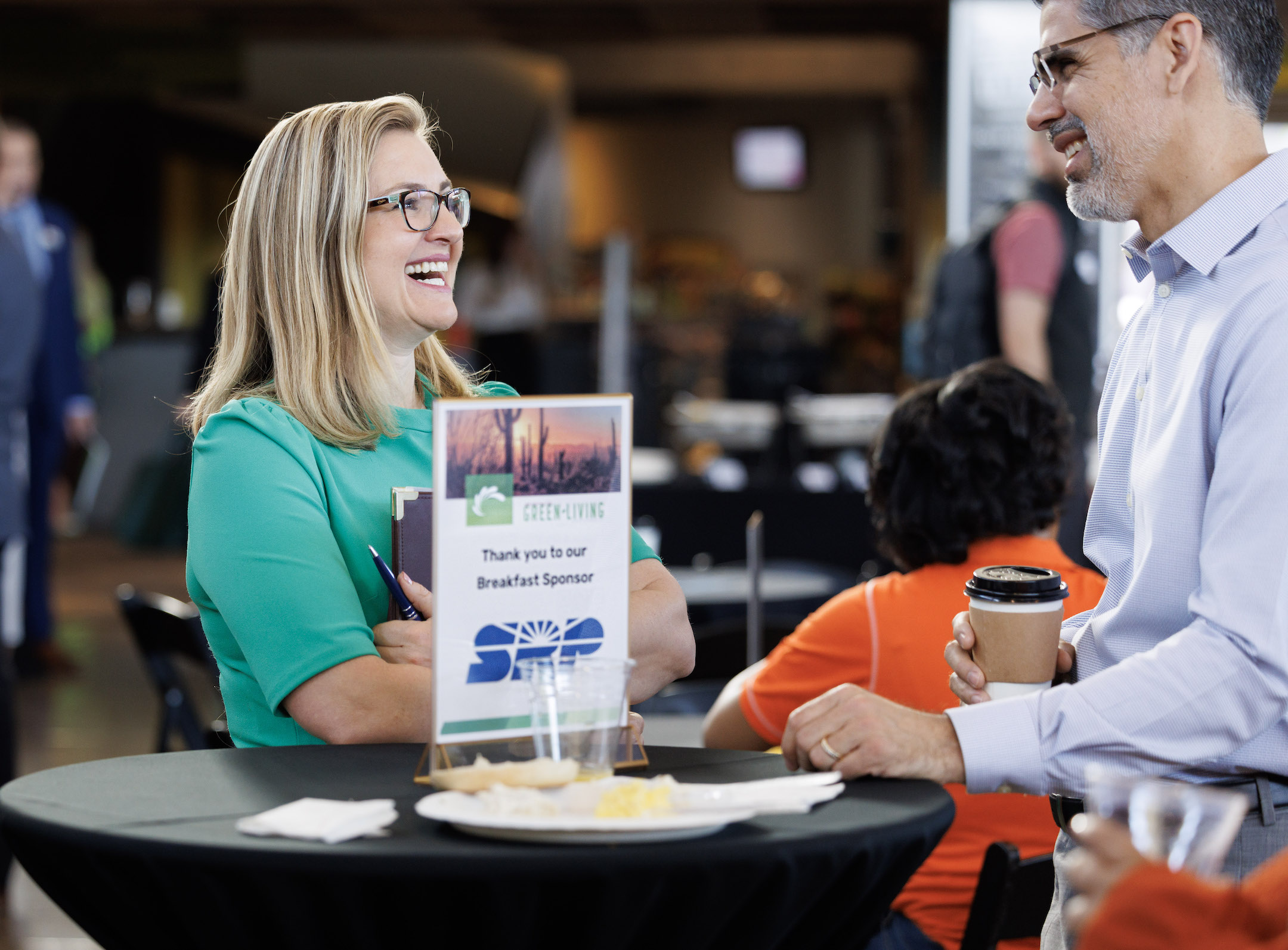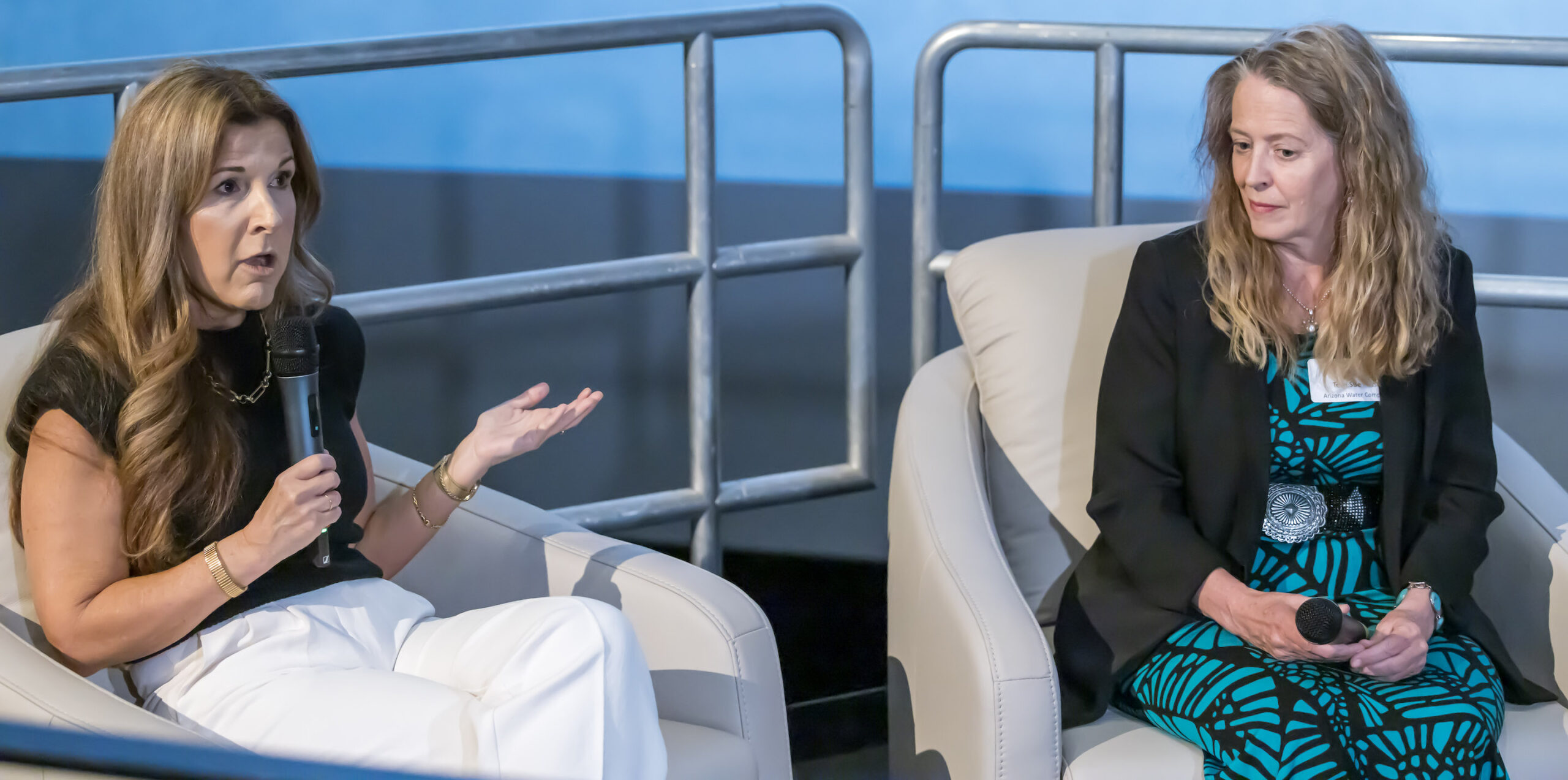By Jordan Gerard
Sustainable goals and innovative solutions were top-of-mind at Green Living Magazine’s and Gensler’s 2023 Future of Sustainability Summit.
The event took place on April 21 at the Arizona Science Center and started with a networking breakfast sponsored by SRP. Throughout the day, leading experts posed both environmental challenges and solutions to audience members for consideration. Panels focused on the nexus between carbon reduction and water and finding innovative sustainable solutions to the ongoing climate crisis.
Gensler Managing Director and Principal Martha de Plazaola Abbott highlighted the importance of the event as she welcomed attendees in her opening remarks.
“This event gives people the chance to hear from key leaders about critical issues and current perspectives on the sustainable future of Arizona,” she said.
The Arizona Science Center was the perfect location to host a sustainability event. President and CEO Guy Labine noted in his welcome address, “When it comes to solving the climate crisis, we must encourage our communities to do better. Organizations like ours have a responsibility to lead by example while also educating the public on sustainability.”
In her keynote speech, Honorable Mayor Kate Gallego highlighted Phoenix’s commitment to net zero carbon emissions by 2040. She also highlighted Super Bowl LVII, which had a 92% conversion rate for zero waste. She hoped the event was a sustainability touchdown for Phoenix when the world was watching.

Gallego touched on the event’s sustainability highlights, including a robot de-packager that converted organic packaging material into compost, autonomous vehicle and electric vehicle sponsors, and a massive tree planting project along the Salt River and at the Phoenix Zoo.
“We want to be known for being a laboratory and leading the way in sustainability,” Gallego said. “If we are going to be the most sustainable desert city we can’t always be following, and so we try new things in the area, and we’ve been proud to showcase them to the world.”
She also touched on November’s bond referendum, which includes investments in sustainable transportation, greener city buildings, and the Salt River waterfront. The latter project received a federal grant that will make the waterfront more active and welcoming.
The first panel of the day was the most requested topic from last year’s audience. Carol Hu from the Greater Phoenix Economic Council moderated the panel on carbon and water reduction targets. The conversation centered around strategic planning, converging public and private sector efforts, how personal goals flow into business goals, and how success is measured.
Arizona Water Company Vice President of Water Resources Terry Sue Rossi talked about the 1980 Arizona Groundwater Management Act that helped to establish safe yields for groundwater by 2025. Safe yield means the amount of water that is pumped out of the ground is equal to or less than the amount of water naturally replenished back into the aquifers. It trickles down to management plans, industry sectors, and regulations, she said.
“It’s important that what we do is sustainable, because we know that the eyes are on us,” she said.
Arizona Water Company serves small communities, and Rossi focused on the company’s flagship program with the City of Casa Grande that was launched in 2021. The Save It program’s goal is to reduce the community water footprint by 15% to lessen the dependence on groundwater. The two entities developed structural conservation measures to be implemented by the city.
“It’s not just about sustainability, but affordable water supply, affordable housing. All of these are important to creating the kind of communities we need to have,” she said.
Personal values flow into business values, especially for panelist Ben Timbrook, senior principal construction engineer at Northrup Grumman. As a parent of a two-year-old, he wants a clean, environmentally friendly world for his daughter to grow up in.
“Our industry utilizes a lot of raw, precious materials and resources,” he said. “When those things are at threat, it impacts our manufacturing and impacts our customers. Sustainability is vital to our industry.”

Rosa Inchausti, the first female deputy city manager in Tempe, said strategic planning has been the city’s standard. It’s important to identify strategies and then communicate them clearly.
What’s more effective than incentives is meeting people where they are, she added. Talking to people early in the strategizing process is key.
“You can work out those differences, but I find that people are willing to do more to help you reach those goals when you’re honest, humanitarian about it, and you explain it and watch how they row the boat with you,” she said.
After the panel, Arizona State University graduate student Melissa McKinley presented a snapshot of her capstone project, “The Beauty of Biodiversity.” McKinley is a masters student in the landscape architecture program, and she’s publishing a handout that empowers people to make the right gardening decisions throughout urban Arizona. The handout gives advice on how to plant a pollinator-friendly landscape.
As the Valley expands rapidly, desert habitats are destroyed and plowed through, leaving little room for wildlife corridors, she said. Her motto, “When you plant what they know, they know where to go,” encourages planting native species, especially pollinators such as saguaro cacti, ironwood trees, native mesquite trees, and others.
“What’s important [is that] desert animals, flora, and fauna have co-evolved for millenia, so they understand what they need,” she said. “When we plant non-natives, we kind of discourage that and disconnect this habitat further.”
Pam Giannonattispoke, Kroger Corporate Affairs Manager/Fry’s Division who also sponsored the event, next about their social impact program: Zero Hunger Zero Waste. In 2022, they rescued over 2,300 tons of edible food and donated it to food shelves. If the food isn’t eligible for donation, it goes into the food waste recycling program. That food is collected on a daily or every-other-day basis and feeds the herd at Stotz Dairy. Last year, 3,000 tons of food was put into the program.
Fry’s has partnered with local schools too. They helped Garfield Elementary School install a garden and create a compost program. They also supported the University of Arizona’s rooftop garden and food pantry.
Before the second panel, University of Arizona geoscience junior Tyler Byland talked about several different campus projects that Students for Sustainability has worked on. The group has taken on three main projects that benefit the UA campus and Tucson.
The first is a retrofit project that upgrades or replaces existing light structures on campus to energy efficient lighting. The second is an interactive energy dashboard that gathers data on the campus’ carbon emissions, energy consumption, and water usage from campus facilities. Finally, the campus vegetation project (spearheaded by Byland in his freshman year) brings native plants to campus. Next year, they plan on installing a vertical plant wall.
Other projects include promoting composting, water quality, gardening, and local education and sustainability. Overall, it contributes to the university’s pledge to be carbon neutral by 2040, he said.
“Our efforts, though seemingly small, can make a large punch in the fight toward a more sustainable future,” he said.
Scottsdale Councilwoman Solange Whitehead moderated the second panel on innovative sustainability solutions.
“We know in Scottsdale, we know in Arizona, our environment is our economy, and the more we do to protect it, the more we have a strong, wonderful state to look at,” she said.
Whitehead asked Ed Zuercher, managing executive director for the Maricopa Association of Governments, how the City of Phoenix managed to get residents on board in 2018 when they increased garbage rates. At that time, Zuercher was the city manager.
He said the city approached it by the value proposition for residents, which was reducing harm to the environment. The value of protecting the environment outweighed the cost of the increase. Phoenix was able to create a better byproduct, cleaner recyclables, tapped into their local market, and created new jobs, Whitehead added.
In his role at Maricopa Association of Governments, Zuercher said operating as a region is more beneficial for all residents because similar problems have no borders. The biggest topic right now is Proposition 400 Extension, which is a regional transportation tax paid for by the Maricopa County voters to create the transportation system that’s in place today. Before the tax contributes to transportation again, the legislature has to approve the proposition to go to voters.
On the I-10 corridor from Los Angeles to Houston, Phoenix has the most intense urban development, along with suburban, ex-urban and rural areas, so planning has to accommodate all of those.
“We’re all linked together in this region, and we realize we’re all going to fall and rise together,” he said.
The next frontiers the region will need to address are air quality and homelessness, Zuercher said. It’s all tied to economic success.
“We know great transportation has built a great economy,” he said. “Air quality is an important component of quality of life, which builds a great economy, and when we’re not all sharing in the upside of the economy, and we have people falling out into homelessness, that’s the issue we have to address to be a great region.”
Senior Adviser to the President of ASU Wellington (Duke) Reiter talked about the benefit of installing solar panels over parking lots. ASU’s solar panels draw 75 megawatts per hour from Phoenix’s 300-plus days of sunlight. Recently, Pat’s Run, which supports Tillman scholars, started and ended under those solar panels.
“If you’re taking something that captures energy from the sun and turns it into something we can use on campus, while also creating public spaces where people want to gather, you’re getting a ‘three-fer,’” he said. “People want to be there, they’re cooler in the shade, and the energy being captured there, we’ll use later that day.”
Talking about his initiative Ten Across, Reiter said people have to think proactively about infrastructure and sustainability. Ten Across is a media platform that offers diverse perspectives and information on proactive decision-making for resilience and sustainability.
Students are leading the way, especially when it comes to their future.
“We’re trying to make everything possible for them to achieve the success they want in their life, career, and around issues of resilience, sustainability, and the environment,” he added.
Kim Luu, who oversees environmental and social governance at semiconductor manufacturer Onsemi, said the days of environment versus business are over. She said they’re seeing more partnerships and interaction across the board.
“What we’re seeing now in business is that it’s good business strategy, not only because customers are asking for it, consumers are asking for it, but it builds resilience within our company,” she said.
About 75% of Onsemi’s revenue came from sustainable products, and the company has a net zero by 2040 commitment. Luu said Onsemi’s intelligent sensors can make electric vehicles charge faster, give them more range, and allow for decarbonization; reducing the barrier of entry for people who want to switch.
Onsemi CEO Hassane El-Khoury recently signed a science-based target initiative to set near-term targets, which means the company has realistic and actual milestones to move toward net zero, Luu said. A short term goal that has worked for the company is selling wastewater sludge for cement manufacturing.
Gov. Katie Hobbs closed the day with a keynote speech. She highlighted recent sustainable goals passed by her administration, including negotiations on Colorado River allocations, expanding the tree canopy, cleaner air and improved resiliency (with a new Office of Resiliency), and natural hazard mitigation.

“We know that our economy and quality of life depend on leadership addressing these risks. We know that people’s lives depend on our leadership,” she said.
Read more good, green news in Green Living’s Good section.






